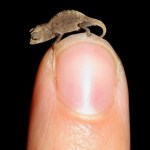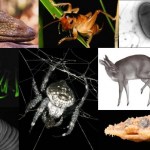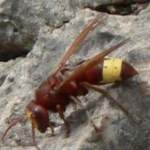Life Sciences
The emergence of "new" diseases is a complicated issue. "New" diseases often just means "new to biomedical science." Viruses like Ebola and HIV were certainly circulating in Africa in animal reservoirs for decades, and probably millenia, before they came to the attention of physicians via human infections. Hantavirus in the American southwest has likely infected many people, causing pneumonia of unknown origin, before the Four Corners outbreak led to the eventual identification of the Sin Nombre virus. Encroachment of humans into new areas can bring them into contact with novel infectious…
Our initial optimism over Huffpo science being a haven for reason in a den of disease-promotion and quackery appears now to be misplaced. It appears the animal rights cranks have made inroads with Bruce Friedrich, a member of PETA and advocate of animal liberation, who has jumped from Huffpo "green" to Huffpo "science". The science gatekeepers at Huffpo have clearly failed.
Writing about "Speciesism: The Movie", he exposes the anti-science ideology of the animal rights movement, and Huffpo science doesn't seem to have noticed:
Every now and then, a movie comes along that is capable of…
New research conducted by Dr. Gary Beauchamp from the Monell Chemical Sciences Center in Philadelphia has shown that seven of twelve species of carnivorous mammals tested lack taste receptors for sweets. According to the article, Dr. Beachamp and his colleagues identified mutations in the mammalian taste receptor for sweets (Tas1r2/Tas1r3) in animals from the Pinnipedia order (sea lions, fur seals and Pacific harbor seals), bottlenose dolphins, Asian small-clawed otters, Spotted hyenas, fossa (member of the mongoose family), and cat-like banded linsangs. In contrast, normal sweet receptors…
While I was editing and posting the pictures for last night's family blogging, SteelyKid came in and said "Daddy, we watched [indistinct name] today, and they created their own story on the show. But I don't know how to do that."
"Sure you do, honey," I said. "You create stories all the time. You were telling me a story last night, something about bears in a cave. You can create stories if you want to."
That cheered her up, and after a little bit of negotiation about who was going to write on what, she created the following story:
That's a SpongeBob activity book that she got from I-don't-…
There are quite a few reasons why I blog. After all, to crank out between 500 and 3,000 words a day, with an average of somewhere around 1,500 by my reckoning) takes quite a commitment. One of the main reasons that I do this is to combat the irrationality that permeates the world, and, since I know medicine, I tend to concentrate mostly on medicine, although I certainly do not limit myself to medicine. Still, over the last seven years I've noticed myself writing less and less about other topics and more and more about medicine. It's been quite a while, for instance, since I've written about…
David Klinghoffer is surprised that his Disco. 'tute colleagues managed to get an article published at the Huffington Post. Klinghoffer's colleague must've known this was coming, and HuffPo isn't notorious for refusing essays, so I can't fathom why it was any sort of surprise. Nor is "pleasant" the word that came to mind on reading the essay, or anything coming from Disco. Anyway, Klinghoffer asks us to "Try to Imagine Our Country's Founding if the Founders Had Not Been Advocates of Intelligent Design:
The Huffington Post pleasantly surprised us today with an excellent piece on the…
In 1977, NASA sent a pair of unmanned probes named Voyager 1 and Voyager 2 into space. Among the infrared spectrometers and radio receivers included on each probe were identical copies of the same non-scientific object: the Voyager Golden Record.
Sheathed in a protective aluminum jacket, the Record is a 12-inch gold-plated copper disk containing sounds and images chosen to portray the diversity of life on Earth: bird calls, whale songs, the sounds of surf, wind, and thunder, music from human cultures, and some 55 greetings in a range of languages, alive and dead. Like lonely time capsules,…
Typically when we think of flying things and influenza viruses, the first images that come to mind are wild waterfowl. Waterbirds are reservoirs for an enormous diversity of influenza viruses, and are the ultimate origin of all known flu viruses. In birds, the virus replicates in the intestinal tract, and can be spread to other animals (including humans) via fecal material.
However, a new paper expands a chapter on another family of flying animals within the influenza story: bats.
I've written previously about the enormous diversity of microbes that bats possess. This shouldn't be…
Image Source: PLoS One
A new tiny species of chameleon (Brookesia micra) was recently discovered in Madagascar. The scientists who discovered the animal speculate that it is likely at the lower limit of size for a vertebrate with complex eyes. Shown in the image above is a juvenile.
At a little over half an inch, the chameleon loses out on being considered the world's tiniest vertebrate. This record is currently held by a recently discovered teeny frog (equally adorable at an average length of 0.3 inches) that was found in a pile of leaves in Papua New Guinea. You can see a photo of the…
Last week, I gave a talk at UNLV titled "A counter-revolutionary history of evo devo", and I'm afraid I was a little bit heretical. I criticized my favorite discipline. I felt guilty the whole time, but I think it's a good idea to occasionally step back and think about where we're going and where we should be going. It's also part of some rethinking I've been doing lately about a more appropriate kind of research I could be doing at my institution, and what I want to be doing in the next ten years. And yes, I want to be doing evo devo, so even though I'm bringing up what I see as shortcomings…
The current issue of The Philosopher's Magazine contains a lengthy interview with philosopher Elliott Sober, a prominent philosopher of biology. Most of the interview focuses on the problem of reconciling evolution and theism, with Sober serving up the standard talking points. For me the interview is a reminder of what I find most frustrating about theistic evolution. Too often the defender of reconciliation acts as though his job is done as soon as he has tossed off a logically possible scenario that includes both God and evolution.
The interview does not seem to be freely available…
Another list for your reading, gift-giving and collection development pleasure.
Every year for the last bunch of years I've been linking to and posting about all the "year's best sciencey books" lists that appear in various media outlets and shining a bit of light on the best of the year.
All the previous 2011 lists are here.
This post includes the following: The Top Cryptozoology Books of 2011.
The Species Seekers: Heroes, Fools, and the Mad Pursuit of Life on Earth by Richard Conniff
When Bigfoot Attacks by Michael Newton
Tracking Bigfoot by Donald Wallace and Lori Simmons
In Search of…
There is a shifting pattern of spam email that I get. A while back, it was practically non-stop gay porn; I commented on this a while back, and laughed it off, which apparently annoyed the people who'd been sending it to me. I think they expected me to be stressed and conflicted and angry at getting photographs of muscular young men with large penises, but really…it doesn't bother me at all. So lately the supply of hunky naked men posing in my in-box has all but dried up.
Instead, my previous criticisms have prompted a flood of commercial spam from middle eastern sites, and the malicious…
Now and again, some well-meaning but clueless person gets it into their head that teaching creationism in the schools is a good idea — that the clash of ideas is a good pedagogical technique. There are cases where that would be true, but doing it in the public school classroom and hashing over a bad, discredited idea vs. good science is totally inappropriate. Reserve that technique for issues where there is substance on both sides.
But now Jay Mathews is trying to revivify this nonsense in the Washington Post, suggesting that Rick Santorum has a good idea with his plan to "teach the…
On Greg Laden's Blog, we learn that "a subspecies of 'Black Rhino' also known as the 'browsing rhino'" has gone extinct in Africa, while Northern White Rhinos and Javan Rhinos have likely met the same fate. Dr. Dolittle says the last known Javan rhinoceros in Vietnam was found "with its horn cut off, most likely a victim of poachers. Another subspecies, The Indian Javan rhino (R. sondaicus inermis), is believed to have gone extinct in the early 20th century." Fifty individuals still linger in West Java, and thousands of White Rhinos still roam in Africa, but on the whole this family is…
This is an exciting day for a comparative physiologist! I just received word from a reader that the top 10 newly discovered species of 2011 have been chosen. This is an annual "contest" put on by the International Institute for Species Exploration at Arizona State University along with an international committee of taxonomists.
The winners, in no particular order, are:
1. Darwin's Bark Spider (Caerostris darwini) that weaves orb webs large enough to span rivers:
2. Bioluminescent mushroom (Mycena luxaeterna):
3. Titanic-eating bacterium (Halomonas titanicae)...literally bacteria that are…
Nature is one of the oldest and most respected scientific journals around. It's been around since 1869 and is said to be the world's most cited journal. What makes Nature unusual these days is that it's a general science journal. Astronomy, physics, chemistry, medicine, biology, it publishes it all. The only other journal of its type that I can think of is Science, which also has a similar high impact factor. In any case, getting published in Nature is a big deal, one that can make a career. Believe it or not, I actually have a Nature publication. True, it's from the 1990s, and, true, I'm the…
In the search for energy efficient animals, I came across this neat little bug, the Oriental hornet (Vespa orientalis) that can apparently derive energy from the sun. These bugs will actually work their hardest when the sun is at its peak, which is in contrast to similar species that work hardest in the morning when it is cool. Researchers have long known that if you shine light on them, an electrical current is generated across their exoskeleton. This means that their exoskeleton acts like a solar panel since it can convert light energy into an electrical current. Last year, researchers…
Why would you want a field guide to all of the carninvores? They live everywhere, so there is no reason to carry around a field identification guide with ALL of them unless you were going everywhere in the whole world on one trip!
Yet, there is such a field guide, Carnivores of the World (Princeton Field Guides), and the truth is, this is ONE OF THE COOLEST BOOKS I'VE EVER SEEN! All the carnivores (almost) in one book. Interestingly, it turns out to be possible. There are fewer than three hundred species of terrestrial carnivore in the whole world, and that is fittable in a single book…
Photo Credit: H. Jusseit
Hans Jusseit, a tuna fisherman, has designed a shield to protect the bait on fish hooks (image above). These are not just any fish hooks. These hooks are for catching large fish, like tuna, using longlines like the one shown in the picture below.
Image: OPRT-Organization for the Promotion of Responsible Tuna Fisheries
One problem with this type of fishing is that hundreds of thousands of seabirds and endangered sea turtles, along with other "bycatch" like sharks and porpoises, get caught on the hooks and die while trying to get to the bait. According to a recent…




